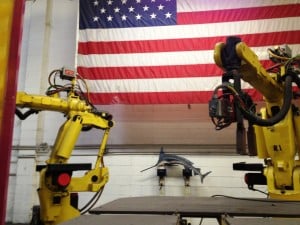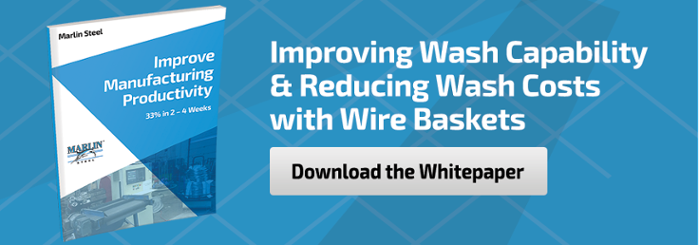 Welding is an incredibly important process in the manufacture of custom metal forms, whether they’re made of sheet metal, steel wire, or both.
Welding is an incredibly important process in the manufacture of custom metal forms, whether they’re made of sheet metal, steel wire, or both.
A well-done weld securely joins two pieces of metal with minimal deformities and loss of tensile strength. Poorly-done welds, on the other hand, leave a weak point in the final product that could rupture, or deform the metal at the point of the weld so that the parts no longer meet production tolerances.
Robotic welding equipment has done a lot to make the welding process more consistent and reliable, but there is still an art to improving productivity with robotic welding.
How can you master this art so that your productiveness on the manufacturing line skyrockets? Here are a few things that have helped Marlin Steel’s production engineers get the most out of robotic welding:
1: Invest in Great Welding Equipment
Back in July of 2014, Marlin Steel acquired an incredible piece of robotic welding equipment from IDEAL Welding Systems: an MFDC (Medium-Frequency Direct Current) welding robot.
This revolutionary machine boasts greatly improved capabilities compared to a traditional AC welder, including:
- Improved Weld Speed. A normal welding machine can complete a weld in 60/1,000 of a second. The MFDC welder Marlin uses can complete a weld in 2/1,000 of a second. This means that in the time it takes an AC welder to finish one weld, the MFDC welder can complete 30 welds.
- Reduced Weld Deformities. A byproduct of the increased weld speed is that there are fewer deformities left in the metal after the weld is completed. The shorter weld cycle reduces the amount of heat and stress the metal is exposed to, limiting deformities such as sharps and burrs.
- Large Welding Table. A typical welding machine can operate on a 4’ x 4’ table. The IDEAL welder has a 10’ x 4’ table, allowing it to handle much larger work pieces without manual assistance.
- Three Dimensional Welding. Most welding machines can only move their welding heads along the X and Y axes. This essentially limits those machines to operating on a flat plane. The IDEAL welder can move along the X, Y, and Z axes all at once, allowing it to handle much more complicated weld patterns independently.
Using more sophisticated equipment allows your production managers greater freedom in automating the welding of larger or more complicated parts.
2: Invest in Training Welding Machine Operators so They Know the Limits of Their Equipment
 To maximize productivity, it is imperative that the operators of your robotic welding machines know their equipment inside and out. Not just the strengths and uses of their welding robots, but the limitations as well.
To maximize productivity, it is imperative that the operators of your robotic welding machines know their equipment inside and out. Not just the strengths and uses of their welding robots, but the limitations as well.
For example, different kinds of welding equipment might use different welding apparatuses and methods, such as electrical resistance welding or arc welding.
Knowing the specifics of the weld operation and the robot’s limitations allows the operator to adjust the production plan for greatest efficiency. Say that you wanted to weld a highly ductile piece of metal, such as aluminum.
Resistance welding is usually not the preferred method for performing these welds because the technique relies on a material’s resistance to electric currents to generate heat for the weld. When the welding machine operator knows this, he or she can make the necessary adjustments, such as choosing to use a different kind of welding process or upping the strength of the electrical current to compensate if no other welding equipment is available.
3: Create Aggressive Goals that are ACHIEVABLE with Meaningful Rewards Attached
It is important to keep production line workers focused and invested in the manufacturing process if you’re going to achieve maximum productivity.
At Marlin Steel, production teams, including the welding teams in charge of the automated welding equipment, are given Big, Hairy, Aggressive Goals (BHAGs) that they have to meet to earn their paycheck bonuses. These bonuses are paid out every pay period based on the performance of each team, so there is a constant short-term motivation to perform.
These goals are kept achievable so that they never feel unfair, but aggressive so that they don’t become low-effort “gimme” bonuses. Also, the bonuses are designed to be significant so that there is an actual motivation to perform.
When workers know that making their bonus can provide a significant boost to their ability to provide for their families in the immediate future, they’re much more motivated to do the best job that they can.
These three steps have helped Marlin Steel master the art of improving productivity with robotic welding. See how Marlin has helped other clients improve productivity by checking out the case study at the link below:



.gif)


